Themed collection Trends in Thermoresponsive Polymers: from Chemistry to Applications

Introduction to trends in thermoresponsive polymers: from chemistry to applications
Theoni K. Georgiou, Richard Hoogenboom and Akihiko Kikuchi introduce the Polymer Chemistry themed collection on trends in thermoresponsive polymers: from chemistry to applications.

Polym. Chem., 2025,16, 233-234
https://doi.org/10.1039/D4PY90151G
Thermoresponsive polycations
This review discusses the structural features of polycations, which make them thermoresponsive, showing either LCST or UCST behavior. The role of hydrophobic counter ions is of particular interest.

Polym. Chem., 2023,14, 3647-3678
https://doi.org/10.1039/D3PY00421J
Thermo-responsive block copolymers: assembly and application
The review focuses on the assembly and application of five thermo-responsive block copolymers containing one or two thermo-responsive blocks, and aims to provide an overview to guide the design of these copolymers and stimulate more applications.

Polym. Chem., 2023,14, 1863-1880
https://doi.org/10.1039/D2PY01597H
Thermoresponsive block copolymers of increasing architecture complexity: a review on structure–property relationships
The position of the monomers within the polymer chain and the 3D structure of the polymer affect the thermoresponsive properties.

Polym. Chem., 2023,14, 223-247
https://doi.org/10.1039/D2PY01097F
Thermoresponsive polymers in non-aqueous solutions
Polymers does not only show phase transition in aqueous solutions but they also do in organic solvents, which is the focus of this review article.
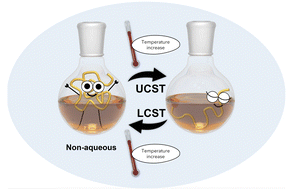
Polym. Chem., 2022,13, 6423-6474
https://doi.org/10.1039/D2PY01147F
Thermoresponsive polymer brush photocatalytic substrates for wastewater remediation
NIPAAm and fluorescein o-acrylate are copolymerized on glass beads to develop multiresponsive heterogeneous photocatalysts that exhibit structural changes at elevated temperatures and alter their photocatalytic performance in wastewater remediation.

Polym. Chem., 2023,14, 2662-2669
https://doi.org/10.1039/D3PY00248A
Responsive tertiary amine methacrylate block copolymers: uncovering temperature-induced shape-shifting behaviour
Responsive polymeric nanoparticles are an exciting field of study, yet little is known about the temperature sensitivity of those based on tertiary amine methacrylate block copolymers.
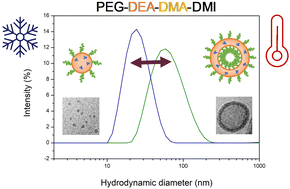
Polym. Chem., 2023,14, 2022-2026
https://doi.org/10.1039/D3PY00287J
Thermoresponsive property of poly(N,N-bis(2-ethoxyethyl)acrylamide) and its multiblock copolymers with poly(N,N-dimethylacrylamide) prepared by hydrosilylation-promoted group transfer polymerization
Poly(N,N-bis(2-ethoxyethyl)acrylamide) (PEOEAm), a new thermoresponsive polyacrylamide, has been studied from the perspectives of synthesis and thermal phase transition.

Polym. Chem., 2023,14, 5060-5070
https://doi.org/10.1039/D3PY01032E
Encapsulation in cooling-induced coacervates augments DNA enzyme activity
The activity of a DNAzyme is enhanced by entrapment in cooling-inducible liquid droplets of UCST-type ureido polymers.

Polym. Chem., 2023,14, 4743-4747
https://doi.org/10.1039/D3PY00923H
Unravelling the thermo-responsive evolution from single-chain to multiple-chain nanoparticles by thermal field-flow fractionation
ThFFF with multiple detection enables monitoring the transformation of block copolymers into single chain nanoparticles stabilized by a shell (SCNP-shell). The SCNP-shell are in dynamic equilibrium with multiple chain nanoparticles.

Polym. Chem., 2023,14, 3302-3308
https://doi.org/10.1039/D3PY00426K
Structural control and functionalization of thermoresponsive nanogels: turning cross-linking points into anchoring groups
Nanogels with cleavable crosslinking points allow for nanostructure modification and functionalization with α-oxoaldehydes (glyoxylic groups).

Polym. Chem., 2023,14, 2998-3007
https://doi.org/10.1039/D3PY00347G
Synthesis of amino acid-derived vinyl polymers with precisely controlled hydropathy and their thermoresponsive behavior in water
Synthesis of amino acid-derived vinyl polymers with precisely controlled hydropathy by ultra-rapid reversible addition fragmentation chain transfer polymerization and their thermoresponsive behavior in water.
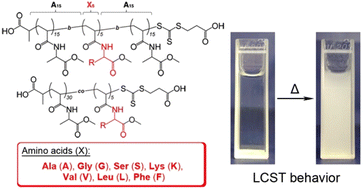
Polym. Chem., 2023,14, 2857-2864
https://doi.org/10.1039/D3PY00353A
Thermoresponsive “irreversible” property change of POSS-crosslinked PNIPAAm hydrogels
Incorporation of a strongly hydrophobic component as a crosslinking point enables reversibility control of property change of thermoresponsive hydrogels.

Polym. Chem., 2023,14, 2771-2778
https://doi.org/10.1039/D3PY00097D
Development of prediction model for cloud point of thermo-responsive polymers by experiment-oriented materials informatics
A prediction model for cloud point was built by a combination of materials informatics and chemical insight.

Polym. Chem., 2023,14, 2383-2389
https://doi.org/10.1039/D3PY00314K
The effect of side chain spacer length on the thermoresponsive behaviour of poly(methylamide acrylate)s
Aqueous solubility of poly(methylamide acrylate)s can be altered via modulation of the side chain spacer length between the polymer backbone and pendant amide functionality whereby a butyl spacer is sufficient to induce LCST behaviour (P(MAmBA)).

Polym. Chem., 2023,14, 2054-2062
https://doi.org/10.1039/D3PY00154G
Amidation of methyl ester-functionalised poly(2-oxazoline)s as a powerful tool to create dual pH- and temperature-responsive polymers as potential drug delivery systems
We present the synthesis of different amine-functionalised poly(2-oxazoline)s, their dual pH and temperature response as well as their capability to as promising stimuli responsive drug delivery vectors.

Polym. Chem., 2023,14, 2034-2044
https://doi.org/10.1039/D3PY00050H
One-pot catalyst-switching synthesis of thermoresponsive amphiphilic diblock copolymers consisting of poly(N,N-diethylacrylamide) and biodegradable polyesters
A method for the syntheses of thermoresponsive amphiphilic diblock copolymers through sequential organocatalyzed polymerizations using group transfer polymerization (GTP) and ring-opening polymerization (ROP), respectively, is described.

Polym. Chem., 2023,14, 1727-1735
https://doi.org/10.1039/D3PY00195D
Self-assembly and salt-induced thermoresponsive properties of amphiphilic PEG/cation random terpolymers in water
Herein, we report the self-assembly and salt-induced thermoresponsive properties of amphiphilic random terpolymers consisting of hydrophilic poly(ethylene glycol) (PEG) and quaternary ammonium cations, and hydrophobic dodecyl groups in water.
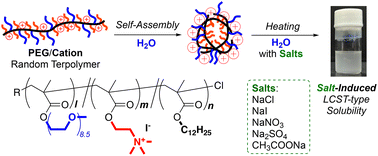
Polym. Chem., 2023,14, 1718-1726
https://doi.org/10.1039/D3PY00013C
Effect of amino group modification at allyl position of methacrylamides on polymerization and polymer pH-/thermo-responsiveness
Effects of primary amino group of methacrylamides on the polymerization and polymer pH- and thermosresponsiveness were investigated.
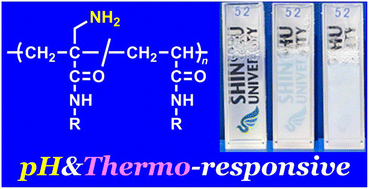
Polym. Chem., 2023,14, 1585-1590
https://doi.org/10.1039/D2PY01611G
Cosolvent effects on the structure and thermoresponse of a polymer brush: PNIPAM in DMSO–water mixtures
Structural characterisation of thermoresponsive polymer brushes in binary DMSO–water mixtures reveals both LCST and UCST behaviour.

Polym. Chem., 2023,14, 1526-1535
https://doi.org/10.1039/D2PY01487D
Contrasting thermoresponsiveness of stereoisomers of a dense 1,2,3-triazole polymer carrying amide side chains
Thermoresponsive behavior of stereoisomers of a dense triazole polymer was studied; mixtures of the isotactic one underwent thermoresponsive gel-to-sol transition, and aqueous solutions of the syndiotactic one underwent LCST-type phase transition.
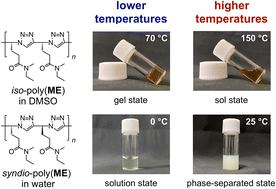
Polym. Chem., 2023,14, 1488-1496
https://doi.org/10.1039/D2PY01528E
Multiphase PCL semi-interpenetrating networks exhibiting the triple- and stress-free two-way shape memory effect
The development of multiphase polymer networks by semi-IPNs composed of homologous polymers using poly(ε-caprolactone).

Polym. Chem., 2023,14, 1478-1487
https://doi.org/10.1039/D2PY01607A
Understanding the monomer deuteration effect on the transition temperature of poly(N-isopropylacrylamide) microgels in H2O
Obtaining deuterated microgels is essential to characterize their architecture and determine their response to crowding using neutron scattering. Here, we explain the effect of deuteration on the phase transition temperature.

Polym. Chem., 2023,14, 1447-1455
https://doi.org/10.1039/D2PY01511K
A systematic study on the effects of the structure of block copolymers of PEG and poly(ε-caprolactone-co-glycolic acid) on their temperature-responsive sol-to-gel transition behavior
The effects of the molecular structure on the temperature-responsive sol-to-gel transition behavior and neat morphology of the block copolymers of poly(ethylene glycol) and poly(ε-caprolactone-co-glycolic acid) were systematically investigated.
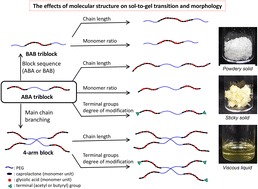
Polym. Chem., 2023,14, 1350-1358
https://doi.org/10.1039/D2PY01574A
Injectable thermoresponsive hydrogels based on (Me)PEG–poly(menthide) amphiphilic block copolymers from bioderived lactone
Synthesis of (Me)PEG–PM block copolymers from a sustainable source, (−)-menthone, and their thermoresponsive characteristics.

Polym. Chem., 2023,14, 1141-1154
https://doi.org/10.1039/D2PY01452A
Thermoresponsive star-shaped polymer with heteroarm type with methacrylates: preparation by living radical polymerization method and its topological effect
Thermoresponsive star-shaped polymer with heteroarm type with methacrylates was prepared by living radical polymerization method with ruthenium catalyst. The effect of the arm structures was also investigated.
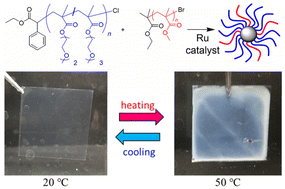
Polym. Chem., 2023,14, 1027-1035
https://doi.org/10.1039/D2PY01518H
Pre- and post-functionalization of thermoresponsive cationic microgels with ionic liquid moieties carrying different counterions
We investigate the effect of different anions on the temperature-dependent solution properties of poly(N-vinylcaprolactam) microgels carrying alkylated ionic liquid vinylimidazolium moieties synthesized by a pre- and post-functionalization approach.

Polym. Chem., 2023,14, 848-861
https://doi.org/10.1039/D2PY01477G
Thermo- and pH-responsive poly[(diethylene glycol methyl ether methacrylate)-co-(2-diisopropylamino ethyl methacrylate)] hyperbranched copolymers: self-assembly and drug-loading
P(DEGMA-co-DIPAEMA) hyperbranched copolymers self-assemble into large polymeric aggregates in aqueous media, when the amino groups of DIPAEMA segments are fully protonated at extreme temperatures (25 °C and 55 °C).
![Graphical abstract: Thermo- and pH-responsive poly[(diethylene glycol methyl ether methacrylate)-co-(2-diisopropylamino ethyl methacrylate)] hyperbranched copolymers: self-assembly and drug-loading](/en/Image/Get?imageInfo.ImageType=GA&imageInfo.ImageIdentifier.ManuscriptID=D2PY01447E&imageInfo.ImageIdentifier.Year=2023)
Polym. Chem., 2023,14, 587-599
https://doi.org/10.1039/D2PY01447E
A self-crosslinking nanogel scaffold for enhanced catalytic efficiency and stability
We report a facile and efficient approach to prepare multifunctional bioinspired platforms under mild conditions that offer increased catalytic efficiency and stability.
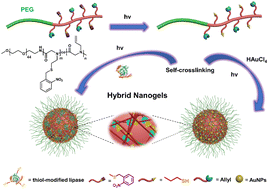
Polym. Chem., 2023,14, 284-294
https://doi.org/10.1039/D2PY01272C
Model dynamic covalent thermoresponsive amphiphilic polymer co-networks based on acylhydrazone end-linked Tetronic T904 star block copolymers
Hydrogels based on acylhydrazone end-linked Tetronic T904 four-armed amphiphilic star block copolymers show thermally-induced aqueous self-assembly and toughening, and cross-link dissociation and association traceable via simple 1H NMR spectroscopy.
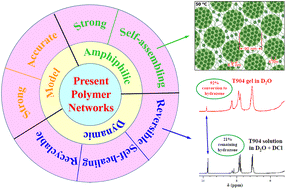
Polym. Chem., 2023,14, 201-211
https://doi.org/10.1039/D2PY01256A
Polymer architecture dictates thermoreversible gelation in engineered emulsions stabilised with branched copolymer surfactants
Polymer architecture allows control of thermoreversible gelation in branched copolymer-stabilised emulsions.

Polym. Chem., 2022,13, 5730-5744
https://doi.org/10.1039/D2PY00876A
Water-soluble copolymers and their hydrogels with pH-tunable diverse thermoresponsive behaviors enabled by hydrogen bonding
Water-soluble copolymers display both UCST and LCST thermosensitivity in aqueous solution due to pH-determined hydrogen bonding between comonomer units, and their hydrogels can be used for information recording and encryption/decryption.
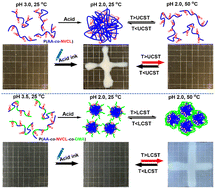
Polym. Chem., 2022,13, 5700-5706
https://doi.org/10.1039/D2PY01044E
Confinement of proteins by thermoresponsive dendronized polymers
Dendronized polymers exhibit the confinement of guest proteins through crowding effects, which is tunable through their thermoresponsiveness. This confinement affords the proteins enhanced thermal stability and can modulate their bioactivity.
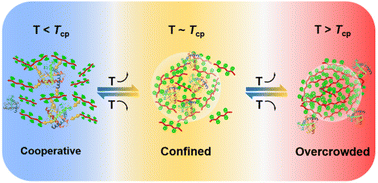
Polym. Chem., 2022,13, 5404-5411
https://doi.org/10.1039/D2PY00957A
About this collection
This themed collection on Trends in Thermoresponsive Polymers: from Chemistry to Applications, Guest Edited by Theoni Georgiou (Imperial College London, UK), Richard Hoogenboom (Ghent University, Belgium) and Akihiko Kikuchi (Tokyo University of Science, Japan) aims to present the latest trends in the chemistry, characterisation, and applications of thermoresponsive polymers. New strategies for the synthesis of thermoresponsive polymers and their characterisation promise to enable a new era of functional thermoresponsive materials in variety fields of applications. Examples include methods to prepare synthetic polymers, hydrogels which show thermoresponsive properties, and their characterisation. These features can impact specific functions such as mechanical properties, self-assembly, or interactions with biological systems, and their applications in a variety of fields, including biomedical applications such as tissue engineering, drug delivery and bioprinting.